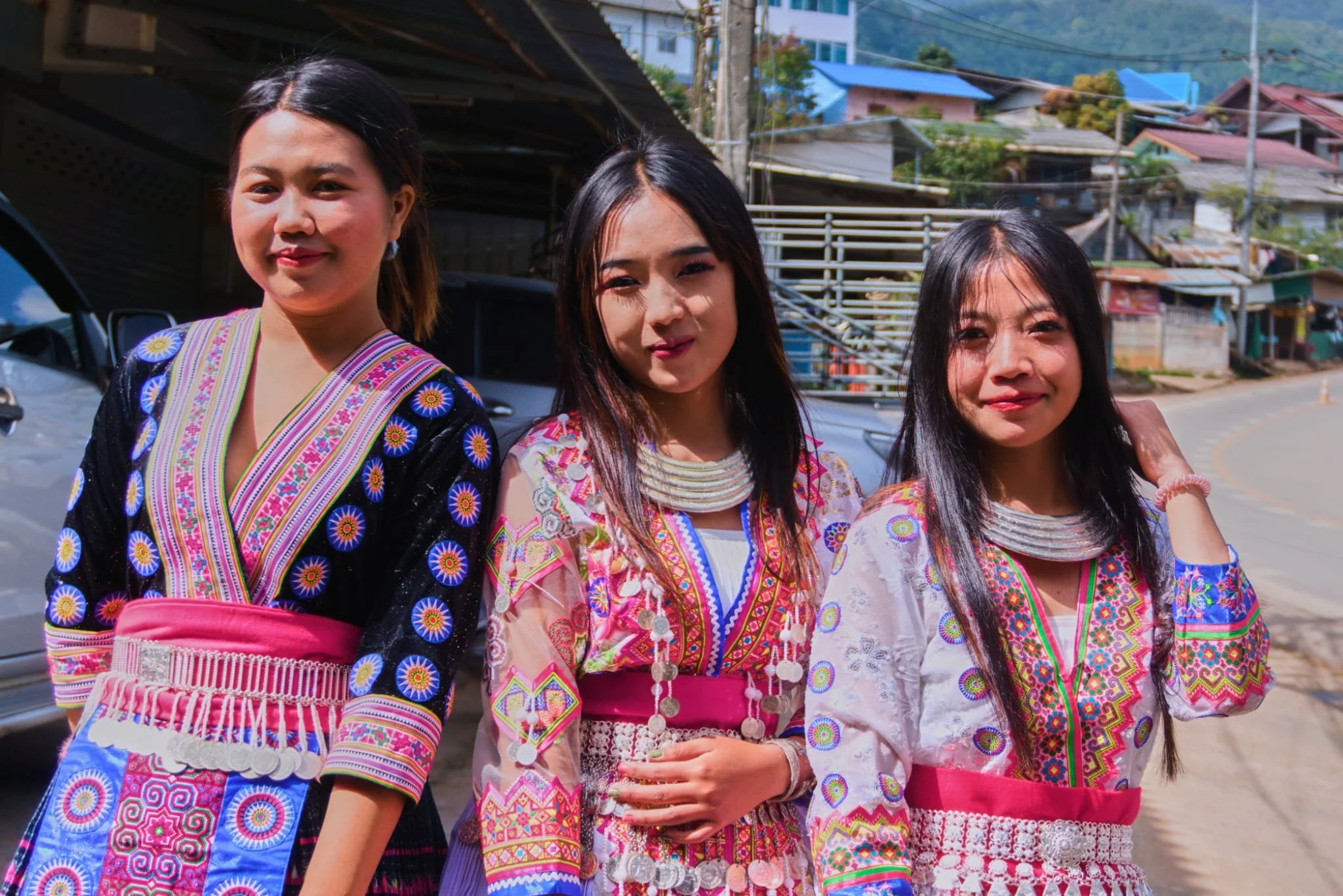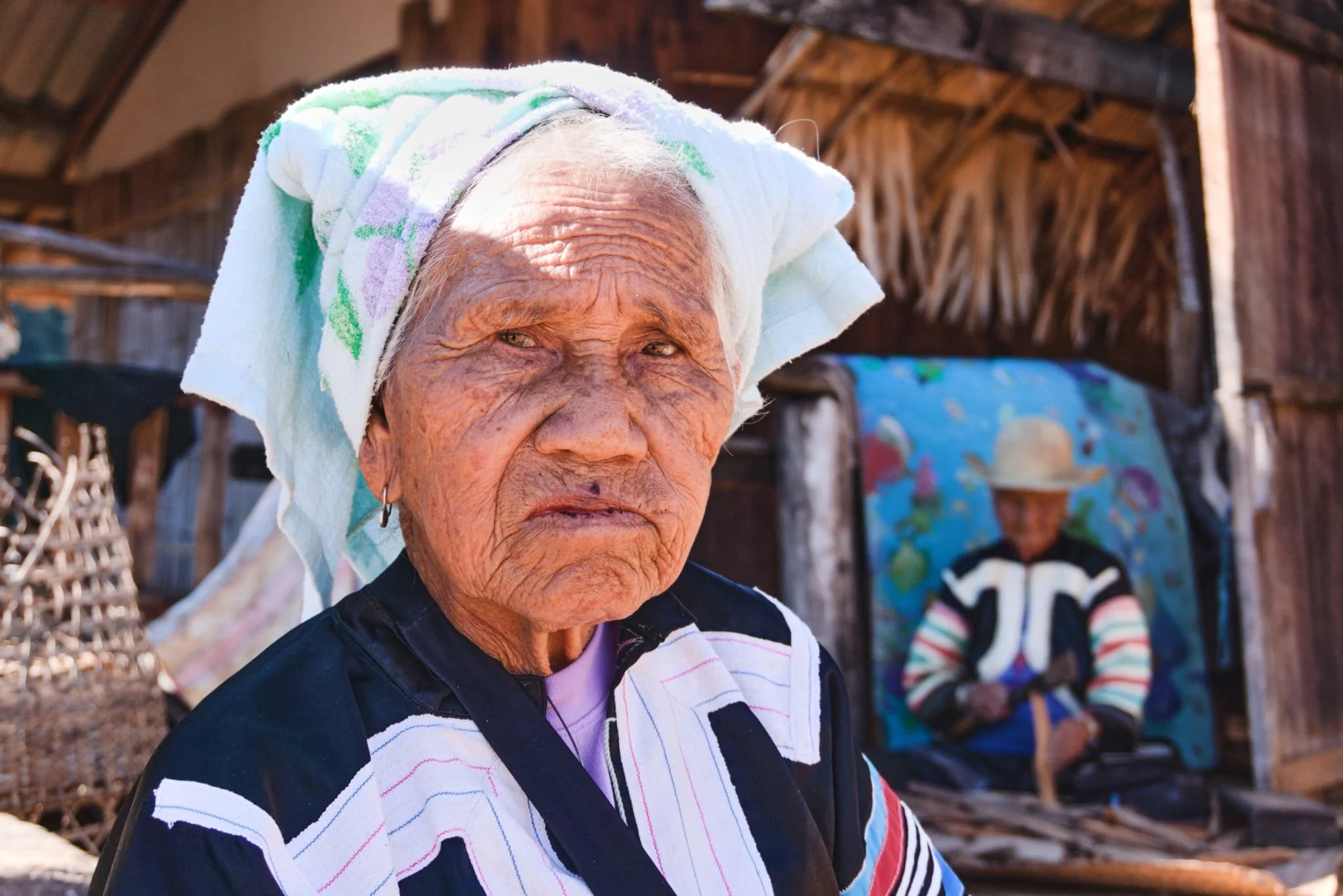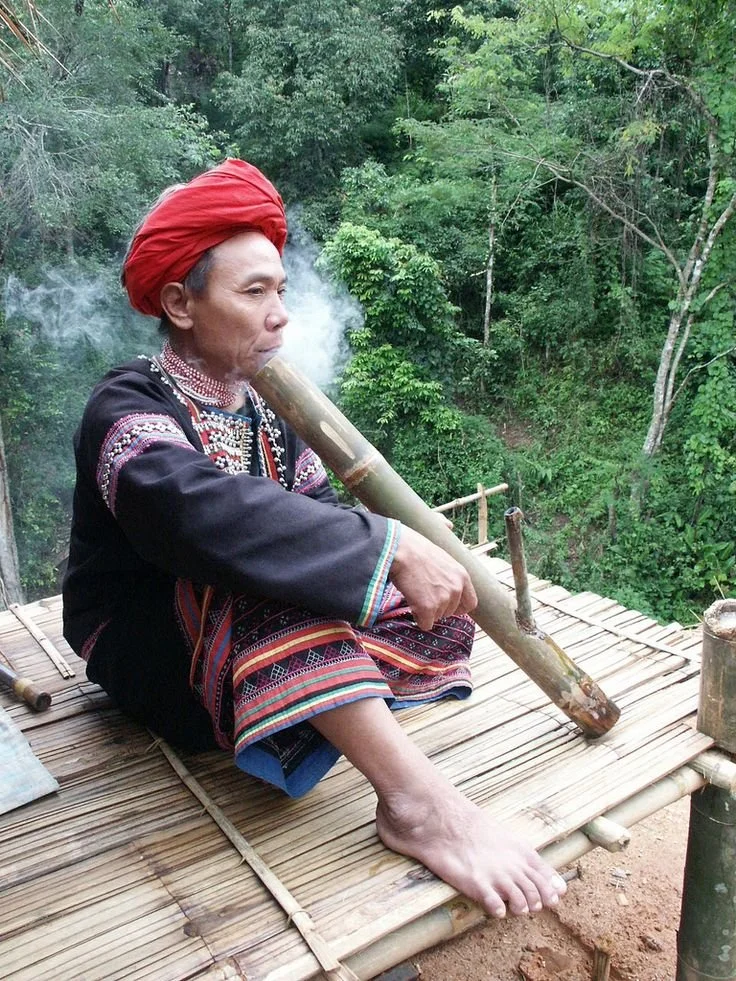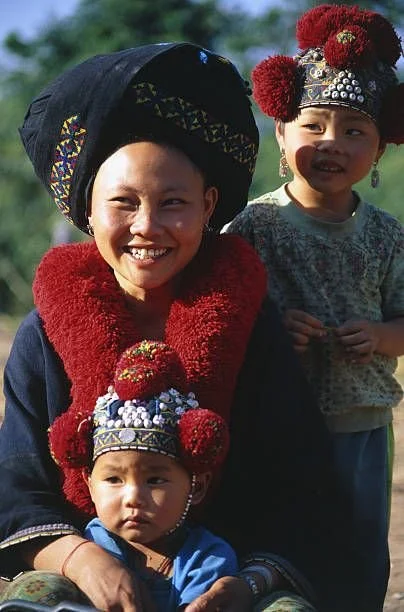Hill Tribes of Chiang Mai: An Ethical Guide to Trekking & Homestays
Written by Pim Meijboom, Co-Founder of PM Tours. Visiting a hill tribe village is the highlight of many trips to Northern Thailand. But it can also be uncomfortable if you end up in the wrong place.
We have all seen the "Human Zoos"—roadside souvenir shops where tourists pay an entry fee to snap photos of women in costumes. That is NOT what we do.
At PM Tours, we take you to villages where we have personal relationships. We eat with the families, sleep in their bamboo huts, and learn about their struggle to maintain their culture in a modern world. Here is how to visit respectfuly.
The mountainous areas of Northern and Western Thailand, including areas surrounding Chiang Mai, are home to many communities of ethnic minorities. These groups are known as hill tribes, or 'Chao Khao' in Thai. Each of these communities follows its own unique culture and way of life, speaking different languages and following different traditions from the dominant Thai ethnic group.
There are seven major hill tribe groups in Thailand. These are the Akha, Hmong, Karen, Lahu, Lawa, Lisu, and Mien groups. Read on to learn more about these fascinating cultures.
Chiang Mai Hill Tribes: Quick Identifier
Karen (Pakinyaw): The largest group. Known for elephant keeping, weaving, and living in stilt houses. Best known for: Jungle Trekking & Elephant Encounters.
Hmong: Known for hemp clothing, batik, and silver jewelry. They live in ground-level houses. Best known for: Markets & Craft Shopping.
Lahu: Famous hunters and gatherers. Known for black/red traditional dress. Best known for: Remote, deep-jungle hiking.
Akha: Recognizable by their spectacular silver coin headdresses and "Spirit Gates" at village entrances.
The "Long Neck" (Kayan): A subgroup of the Karenni. See our Ethical Warning below.
The Akha
The Akha people are an ethnic group believed to have originated from China, although some believe they first came from Burma (now Myanmar). They live across various parts of Thailand, Myanmar, Laos, Southwest China, and some parts of Northern Vietnam. In each of these countries, they are a minority ethnic group, and the population spread across the continent totals around 400,000. The Akha people probably first settled in Thailand as early as 1903, establishing their first village in the Payaphai region near the border with Burma.
Like many hill tribe communities, the Akha people are expert farmers. Before the introduction of the royal project, their primary source of income was opium poppy farming. These days, however, their main products are coffee, mountain rice, corn, and soybeans.
Language
The language spoken by the Akha tribe is a Lolo/Yi branch from the Tibeto-Burman language group. It's a tonal language featuring unique phonetics, distinguishing it from surrounding dialects. The tribe uses no traditional written language; missionaries and linguists visiting the area have worked to develop a variety of writing schemes, but despite this, most people within the tribe remain relatively illiterate. Verbal storytelling and songs preserve their history and beliefs.
Clothing
Traditional Akha dress is vibrant and intricate, reflecting their cultural identity and social status. Women wear elaborately embroidered jackets, skirts, decorated sashes, and headdresses adorned with silver ornaments. Traditional Akha clothing also includes an ornate headdress, which was never taken off - even when they were asleep! This is less common nowadays, and the headdress is reserved for special occasions and tourist events. The tribe's young women typically wear the most elaborate and decorated clothing, whereas the older women wear clothing with less ornamentation.
Men within the Akha tribe wear more simple attire suited for their agricultural lifestyle, including loose-fitting trousers, a white vest, and a blue jacket.
Culture and Traditions
Akha culture revolves around animistic beliefs, emphasizing harmony with nature and ancestral reverence. Rituals like spirit ceremonies and ancestor worship are integral, shaping their worldview and social structure. Gender roles are distinct, with women often responsible for household duties while men engage in agriculture and hunting.
The community celebrates many events and festivals, one of the largest of which is The Swing Festival, which takes place at the peak of the rainy season each year. The festival celebrates life and commemorates the fertility goddess before the coming harvest season. It's regarded as the 'women's new year' and is a huge celebration for the women of the village, with one of the major rituals including women flying high on bamboo swings, proclaiming chants to the gods for a year of good harvest. Visitors are welcome to witness this festival, and it's incredible to watch!
The Hmong
The origins of the Hmong people can be traced back to southern China, where they lived in an agrarian society for centuries. However, political instability and conflicts led to their migration to different regions, including the mountainous areas of Laos, Vietnam, and Thailand. In the mid-20th century, the Hmong became embroiled in the Vietnam War, and many fled to Thailand as refugees, where they established thriving communities in the northern regions.
Today, the Hmong population is estimated to be around 4 to 5 million worldwide, with significant populations in China, Southeast Asia, and the United States. In Thailand, they are primarily concentrated in the northern provinces, such as Chiang Mai, Chiang Rai, and Mae Hong Son, where they maintain their traditional way of life amidst the region's breathtaking landscapes.
Traditionally, the Hmong people practiced subsistence agriculture, cultivating crops such as rice, corn, and vegetables on the steep mountain slopes. While agriculture is a significant part of their livelihood, many Hmong have diversified into other professions, including handicrafts, tourism, and small-scale business ventures.
Language
The Hmong people have their own distinct language, which belongs to the Hmong-Mien language family. Despite the influence of dominant cultures in their regions, the Hmong have managed to preserve their language through oral traditions and community-based education.
Clothing
Vibrant textiles, intricate embroidery, and eye-catching colors characterize Hmong clothing. Traditional garments usually feature complex patterns made by techniques including batik and silk embroidery. Textiles play an important role in Hmong culture, and a considerable amount of skill goes into creating these garments - girls as young as five are taught to embroider. The traditional clothes worn by tribe members make them uniquely recognizable, and you'll often see photographs of the Hmong people in travel brochures and on-tour advertisements about Asia.
Culture and Traditions
The Hmong tribe is broken down into 18 smaller subsects known as clans. These clans are groups of families sharing the same name, with links to one common ancestor. The concept of these clans emerged when much of Southeast Asia was impacted by war, and the mountainous highlands were a very unsafe place to live. By banding together in familial groups, people had a support network in place to rely on during turbulent times. This has continued throughout history; even today, clanship remains integral to Hmong culture.
Hmong culture is rich in traditions and celebrations that reflect their agricultural lifestyle and spiritual beliefs. One of the most important festivals is the Hmong New Year, celebrated at the end of the harvest season with colorful rituals, traditional games, and vibrant attire. Other significant celebrations include weddings, funerals, and ceremonies to honor ancestors and spirits.
The Karen
The Karen hill tribe traces its roots back to ancient times, with scholars speculating about their migration from Tibet or Mongolia over a thousand years ago. As one of the largest ethnic minority groups in Thailand, they have inhabited the country's mountainous regions for centuries, maintaining their distinct cultural practices amidst changing landscapes and political dynamics. Comprising various subgroups, the Karen people have a distinct identity shaped by their unique history, traditions, and ways of life.
Traditionally, the Karen hill tribe has relied on agriculture, cultivating rice, corn, and vegetables on terraced hillsides. Hunting, gathering, and fishing also supplement their diet, with some communities engaging in handicrafts such as weaving, basketry, and jewelry-making for economic sustenance. However, modernization and external influences have led to shifts in livelihood strategies, with some Karen people seeking employment outside their traditional occupations.
Language
The Karen people speak various languages belonging to the Karenic branch of the Tibeto-Burman language family. One of the most widely spoken Karen languages is S'gaw Karen, also known as Karen, the official language of the Karen National Union in Myanmar.
S'gaw Karen is characterized by its tonal nature, with high, mid, and low tones conveying different meanings. It is also notable for its complex system of consonant clusters and vowel sounds and its use of classifiers to indicate noun class and grammatical relationships.
The language features a rich oral tradition, with storytelling, folk songs, and poetry playing significant roles in Karen culture. Additionally, S'gaw Karen has its own script, adapted from the Burmese script used in literature and religious texts.
In recent years, efforts have been made to preserve and promote the Karen language through education initiatives, cultural programs, and publications. Despite challenges such as displacement, conflict, and assimilation pressures, the Karen people continue to safeguard their linguistic heritage as an integral part of their identity and cultural resilience.
Clothing
Karen attire reflects their cultural identity and practical needs. The tribe's women usually wear vibrantly colored kaftans, blouses, and skirts adorned with intricate patterns, while men wear traditional garments like loincloths and tunics. Different Karen groups living in various areas across Asia wear different traditional clothing; none wears one specific outfit.
Culture and Traditions
Central to Karen culture are communal values, respect for nature, and a deep connection to their ancestral lands. Traditional beliefs passed down through generations emphasize animism and ancestor worship, with rituals and ceremonies playing significant roles in everyday life. The Karen people also have a rich oral tradition, with folk tales, songs, and dances preserving their heritage and wisdom.
Throughout the year, the Karen people celebrate various festivals and ceremonies that reflect their agricultural calendar, religious beliefs, and cultural heritage. Events like the Karen New Year, held between December and January, feature vibrant processions, traditional music and dance performances, and elaborate feasts, providing community bonding and cultural expression opportunities.
Distinguishing the Karen Tribe from the Long Neck Group:
If you have read about Northern Thailand, you might be familiar with the Karen tribe - as you may have heard of the Long Neck Karen subgroup. It's important to differentiate between the Karen hill tribe as a whole and the Long Neck Karen subgroup, often sensationalized in tourist attractions for their distinctive practice of wearing brass rings around their necks. While the Long Neck Karen, also known as the Padaung, belong to the Karen ethnic group, they represent only a small fraction of the broader Karen community. Viewing the Karen people solely through the lens of the Long Neck subgroup overlooks the diversity and complexity of Karen culture and perpetuates stereotypes.
The Lahu
The Lahu hill tribe is believed to have migrated from southern China several centuries ago, settling in the mountainous regions of present-day Thailand, Myanmar, Laos, and parts of China. As one of the indigenous ethnic groups of the region, the Lahu people have maintained their distinct identity amidst changing political landscapes and cultural influences.
Traditionally, the Lahu people have practiced subsistence agriculture, cultivating rice, corn, and vegetables on terraced hillsides. The hill tribe is also proud of their hunter-warrior heritage, which is honored through hunting practices that provide meat for their diet.
Language
The Lahu people speak a language belonging to the Loloish branch of the Tibeto-Burman language family. Lahu is characterized by its tonal system, with four distinct tones that differentiate meaning. It is a primarily oral language with a rich tradition of storytelling, folklore, and oral history passed down through generations.
Clothing
Lahu attire reflects cultural identity and practicality, with clothing designed to withstand the rugged terrain of the mountains. Both men and women wear a robe made of hand-woven cloth, traditionally in black and embroidered with colorful patterns on the lapels, collars, and hems. These garments often incorporate natural materials and traditional weaving techniques passed down through generations.
Culture and Traditions
The traditional religion of the Lahu hill tribe is polytheism. However, Buddhism was introduced in later history and became widespread over time.
The Lahu people follow severe and strict social rules, emphasizing the firm principles of right and wrong. Respect for elders is placed at the forefront of Lahu life, and members of each group answer to their elders' collective will. Compared to other hill tribes, much less importance is placed on extended family within Lahu culture. Despite this, they are still a community that works together, with unity an essential point within their belief system.
The Lawa
The Lawa Hill tribe is one of the smaller ethnic groups in Asia, with a population of around 20,000 people. The group is of Khmer (Cambodian) origin, and it's believed that they migrated to Thailand over 900 years ago - making them some of the region's earliest inhabitants. The Lawa people have inhabited the mountainous areas of present-day Thailand for centuries, maintaining their distinct identity throughout the changes of time.
Traditionally, the Lawa people have farmed rice as their main livelihood. In the modern day, many Lawa people have integrated into modern mainstream Thai society and have jobs in urban areas.
Language
The Lawa people speak a language belonging to the Austroasiatic language family. However, due to historical and cultural factors, the Lawa language has experienced significant influence and borrowing from neighboring languages, particularly Thai. As a result, variations in dialects and linguistic features may be observed among different Lawa communities.
Clothing
Traditional Lawa attire reflects cultural identity and practical considerations, with clothing designed to suit the subtropical climate and rugged terrain of the mountains. Beads hold significance within Lawa clothing, with young unmarried girls wearing bright orange and yellow beads to signify their status.
Due to external influences and modernization, traditional attire is less commonly worn in everyday life.
Culture and Tradition
Lawa religion is very mixed - in both the East and West Lawa villages, you'll find people who practice Christianity, Buddhism, Animism, and even a mixture of all three. American missionaries have been active within the villages, which has resulted in a large Christian population - Christmas is even celebrated within some villages!
The Lawa people strongly believe in the spirit world, and it's believed that many village elders hold spiritual powers and can connect this world with the spirit world. One of the main Lawa festivals is held before the start of the planting season, and it is centered around asking the spirits for a good crop.
The Lisu
The Lisu hill tribe is believed to have originated from the Tibetan plateau and migrated southward following the Salween River Valley to present-day Thailand, Myanmar, India, and China. As one of the indigenous ethnic groups of the region, the Lisu people have maintained their distinct identity amidst a backdrop of changing landscapes and historical dynamics.
Traditionally, the Lisu people use agriculture as their primary source of income by keeping livestock and cultivating plants, including rice, corn, and vegetables, on terraced hillsides. Most of their villages sit at an altitude of over 1000m, and they usually live close to markets to trade their produce. In the past, opium was a popular cash crop farmed by the Lisu people.
Language
The Lisu people speak a language belonging to the Tibeto-Burman language family, characterized by its tonal nature and complex grammatical structure. Lisu is primarily oral, with a rich tradition of storytelling, folklore, and oral history passed down through generations. While the Lisu language has its own script, it is less commonly used today, with many Lisu individuals preferring to communicate in Thai or other dominant languages of the region.
Clothing
Lisu attire is renowned for its vibrant colors, intricate patterns, and distinctive accessories. Women often wear brightly colored tunics over long pants, and many wear the traditional tassel head turban, although this has become less popular in modern times. The clothing worn by the men is less colorful, consisting of a black jacket worn with blue or green trousers. Also, Lisu clothing is often embellished with silver ornaments, beads, and tassels, reflecting the Lisu people's craftsmanship and artistic expression skills.
Culture and Tradition
The Lisu hill tribe has strong spiritual beliefs central to their culture. They believe all animate things, some inanimate things, have an associated spirit; these spirits are believed to have emotions and feelings as humans do. The most important spirits in the spirit world are those of water, ancestors, mountains, and villages. As a result, many Lisu villages are located close to water, and all Lisu villages contain a guardian spirit shrine that looks over and protects that village.
Similarly to many hill tribes, the largest celebration in the Lisu calendar is the Lunar New Year. This is celebrated with food, music, and drinking, and celebrants wear their finest jewelry and clothing to display the previous year's success.
The Mien
The Mien hill tribe, also known as the Yao, trace their origins to southern China, where they lived for centuries. Today, they are one of the largest ethnic groups in Asia, with groups settled in Thailand, Laos, Myanmar, and Vietnam. In Northern Thailand, over 100 Mien villages are spread throughout the mountains.
Outside of Asia, around 20,000 Mien people are living in the United States. This is a result of the conflict within Laos when the US government recruited many Mien people to fight against the communist regime. When the communist regime took control of the country, the Mien people were seen as the enemy due to their assistance to the US. Many chose to flee the country, becoming refugees. In turn, the US government allowed many Mien people who had fought on their behalf to enter the USA, which is why so many reside there today.
Like many indigenous ethnic groups, the Mien people have preserved their distinct identity amidst changing political landscapes and cultural influences.
Language
The Mien people speak a language belonging to the Hmong-Mien language family, characterized by its tonal nature and complex grammatical structure. Mien is primarily oral, with a rich tradition of storytelling, folklore, and oral history passed down through generations. While the Mien language has its own script, it is less commonly used today, with many Mien individuals communicating in Thai or other dominant languages of the region.
Clothing
The Mien traditional clothing is most recognized for its wrapped cloth turban, which both men and women wear. Clothing often consists of black or dark blue cotton jackets, a red neck collar decorated with silver ornaments, and a cream sash. Long striped trousers are worn on the bottom. These garments are incredibly intricate and take a lot of time to craft, depending on the number of stripes.
Culture and Tradition
Mien society is organized around a clan structure, similar to the Hmong tribe. This allows individuals living in dispersed areas to experience a sense of kinship, which is very important in life within remote settlements. The Mien people are a very close-knit group, and families look after their neighbors well. During the busy harvest season, different households lend family members to neighbors who need them - helping one another is an important value.
The Mien people have strong spiritual beliefs. Their religion is a combination of animism and Taoism, and they predominantly worship the spirits of their ancestors. Every house contains a 'Mienv Baaih,' or spirit altar, which signifies that spirits are allowed to enter the house and are welcome, and a list of names of deceased ancestors and relatives is placed upon this altar.
Visiting Hill Tribes
If you've spent some time researching popular tourist activities in Chiang Mai, you will most likely have seen information about visiting hill tribes. Many people choose to visit hill tribes, particularly the Long Neck Karen Village, which is a very popular tourist attraction.
Visiting hill tribes in Chiang Mai raises a lot of ethical questions. The Long Neck Karen Village, in particular, has been described by some as exploitative - rather than visiting an authentic village and learning about the way of life, it is essentially a tourist attraction, and it's difficult to know how the people 'on display' in the village feel about being there.
On the flip side of this, supporting Thailand's hill tribes economically is quite essential - many members of various tribes don't have permanent resident status in the country, which makes employment hard to find. Typical methods of earning an income involve farming and hill tribes traditionally use slash-and-burn farming techniques, which are now illegal in Thailand due to the pollution they cause. Many hill tribes have adapted to these issues by turning to tourism as a form of income - so if no tourists visit, their income streams are further reduced. In addition, the hill tribes in Northern Thailand make up a part of the area's culture and have a fascinating history. As tourists, they're fascinating people to engage with and learn about.
So, what's the answer?
It's possible to interact with different hill tribes ethically, and many tours are on offer that enable you to do this. An example of this is our Elephant Freedom Village Tour, which visits an elephant sanctuary created by Non, a member of a local Karen Tribe. On this tour, as well as supporting Non and his tribe, visitors also get the chance to learn about the deep connection the Karen Hill Tribe holds with elephants.
Our jungle trekking tours, like the Exclusive Jungle Trekking and Mae Wang National Park trekking, are run by ethnic Karen tribal members. They are the guides during the trekking and host you in their villages at homestays, improving their economic future significantly.
Many day trips in Chiang Mai make stops at markets and restaurants run by members of different hill tribes, where you can support them economically by purchasing their produce and handcrafted souvenirs. Our Doi Inthanon Tour visits a Hmong Tribal market, where you can purchase locally produced coffee, fruits, wine, and handicrafts. Supporting hill tribes this way is one of the most ethical and beneficial options you can choose.
Don't hesitate to contact us if you have any questions about the hill tribes of Chiang Mai.










